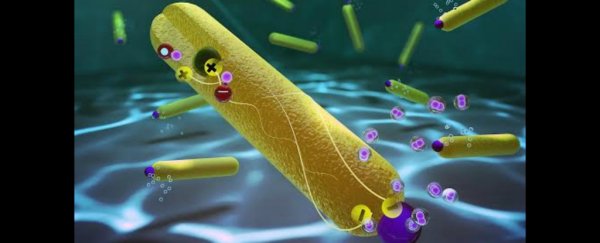If scientists could find a way to cheaply and easily split water into its molecular parts, it would give us access to an incredibly clean and renewable energy source - hydrogen fuel. When burnt with oxygen, hydrogen fuel produces no emissions, and in theory, it's simple enough to produce - you just take water and run an electrical current through it to produce hydrogen and oxygen. But at the moment, this process uses up so much electricity to make, it's not exactly feasible.
Now researchers have performed one of the two steps in this process, known as reduction, with 100 percent efficiency - completely annihilating the previous record of 60 percent. That means that all the energy going into the reaction comes out the other side, and suggests that if the first step of water-splitting - oxidation - can be improved upon, hydrogen fuel could be a viable, emissions-free candidate to power our vehicles and electronic devices.
"I strongly believe that the search for clean and renewable energy sources is crucial," lead researcher Lilac Amirav from the Technion-Israel Institute of Technology in Israel told Phys.org. "With the looming energy crisis on one hand, and environmental aspects, mainly global warming, on the other, I think this is our duty to try and amend the problem for the next generation."
The process was so efficient because it was powered entirely by light, using nanorods as the catalyst that drives the reaction forwards. In the majority of reactions we learn about at school, catalysts are chemicals, but the 50-nanometre-long nanorods used in this system are known as photocatalysts, and they work by absorbing photons from a light source, and then releasing electrons to help split water into hydrogen and oxygen.
"Our work shows that it is possible to obtain a perfect 100 percent photon-to-hydrogen production efficiency, under visible light illumination, for the photocatalytic water splitting reduction half-reaction," said Amirav. "These results shatter the previous benchmarks for all systems, and leave little to no room for improvement for this particular half-reaction … the potential here is real."
To give you a little context here, splitting water requires two steps because it's not quite as straightforward as ripping apart the three atoms in H2O. The full reaction requires two molecules of H2O to be put in, which are then separated through oxidation and reduction, as Lisa Zyga explains for Phys.org:
"In the oxidation half-reaction, four individual hydrogen atoms are produced along with an O2 molecule (which is discarded). In the reduction half-reaction, the four hydrogen atoms are paired up into two H2 molecules by adding electrons, which produces the useful form of hydrogen: H2 gas."
That last half of the reaction is what has now been improved, and the 100 percent efficiency refers to the fact that all of the photons shone onto the nanorods generated electrons.
At this efficiency, the reduction half-reaction produces about 100 H2 molecules per nanorod every second - and each sample contains about 600 trillion nanorods, which means a whole lot of hydrogen fuel can be generated quickly.
The key to this success was identifying a bottleneck in the process - the fact that every time an electron left the catalyst, it left a vacant hole, which then needed to be removed in order to continue on with the process. By redesigning the nanorods to streamline this process, the researchers increased the efficiency from 58.5 percent to 100 percent.
The team is now working on making the system more scalable. Right now, it requires a very high pH level, which isn't ideal for real-world applications, and the nanorods can also become corroded over time. The goal is that by perfect this half-reaction, it'll take hydrogen fuel a step closer to becoming a hydrogen fuel source.
"We hope to implement our design rules, experience and accumulated insights for the construction of a system capable of overall water splitting and genuine solar-to-fuel energy conversion," said Amirav. "I believe this is an important milestone."
The research has been published in Nano Letters.
